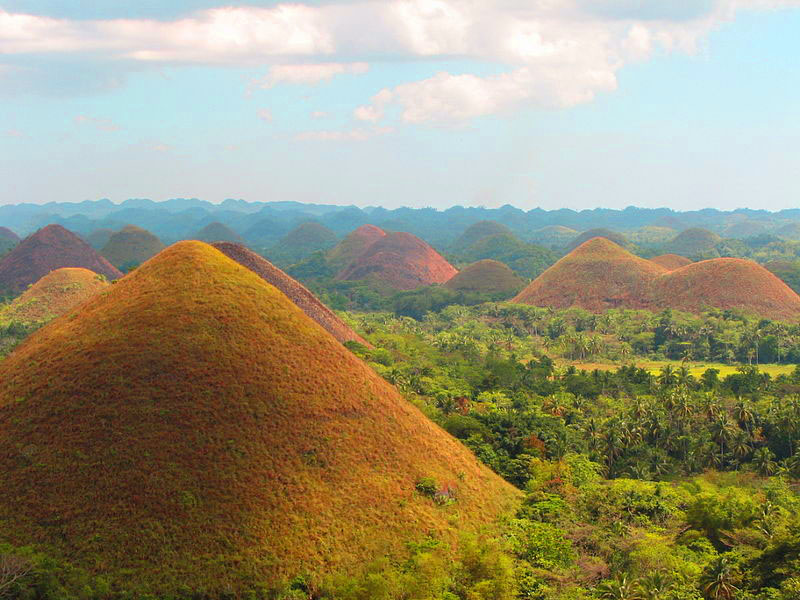
Posted on 30 April 2012 by RE Team
The Bohol Province of Phillipines is home a true natural wonder, popularly known as Chocolate Hills. The name may sound delicious, but this name is given due to the unique color and shape of the hills found in the region.

Nature's Wonder - Chocolate Hills of Philippines
Chocolate Hills are groups hills spread across an area of around 50 square kilometer. These are perfectly shaped domes of short height, the highest being around 400 feet and the average is at 160 feet. It is hard to believe that these are natural structures but not man made landscape. The hills are beautifully covered with green grass during the rainy season and during dry season the grass get a brown color. These brown color hills look like cookies of chocolate and hence the name.
There is no unanimous geological explanation on these wonderful hills. The most widely accepted theory explains these conical karst hills as formations created ages ago by the uplift of coral deposits and the action of rain water and erosion. A recent theory explains that an ancient sub-oceanic volcano self-destructed and chunks of it were dispersed over the region.
The vegetation of the Chocolate Hills are is unique, covered with various hard grass species, ferns and compositae. It is also home to the unique primate species Tarsier. Unfortunately the flora and fauna of the Chocolate Hills are recently threatened by local querying.

Posted on 30 March 2012 by RE Team
<h4 class=”shadow-bringer shadow”>Bar-headed Goose</h4>The birds are the most expert migratory animal on earth and they can overcome any obstacles on their way even it is the highest obstacle on earth, the Everest. Yes, it is very true for one migratory bird, Bar-headed Goose. This Asian goose is now considered as the highest flying bird in the world.

The Pretty Bar Headed Goose - Photo Wikipedia
A recent GPS survey reveals that the bar-headed Goose starts migrating from their breeding home at central Asia (Mongolia) and covers more than 5000 km in two months to reach the low lands in India. These low lands are grazing grounds for the birds in winter as the grass on the high altitude dry up. The total migration takes around two months, as they take frequent stop.
The most interesting and puzzling thing about their migration is that they cross the highest mountain range on Earth, the Himalayan, in a single flight within eight hours. They choose the toughest and highest route of the Himalayan crossing the Everest to reach their destination. The GPS study records that the geese fly over 6,500 meter (22000 feet) in the Himalayan range. But there are reports of the birds flying over the mount Everest at around 30000 feet.

Bar Headed Goose - Anser Indicus @BBC photo
Another very contrasting fact about the Bar-headed bird is that unlike other high flying birds that reach high altitude by soaring and gliding up, the Bar-headed goose reaches the extra-ordinary height by smartly flapping their wings. This is the reason why these geese don’t depend on the tail-wind on the Himalayan range, in fact they deny the winds and starts climbing up high altitude when the wind blows out. The bird’s body is specially made to meet this exceptional capability. More red-blood cells and more capillaries than normal birds deliver their muscles more oxygen than others.
Though their flying and migration nature is confirmed, yet it is still not known clearly why these birds take such a hard route. There are lower passes available in the Himalayan range, that could have given them easy passage. A hypothesis suggests that the geese choose to fly over rather than around the Himalaya is that the birds have been doing so for millions of years—long before the mountains reached their current heights.






Recent Comments